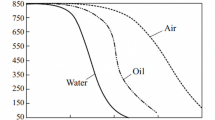Abstract
The development of methods for evaluating the cooling capacity of quenching media can be divided into two main eras. In the first era (before the appearance of computers) the estimation of the cooling capacity of quenching media was qualitative. The second era is characterized by the appearance of new technologies, for example, automatically controlled heat treatment that require a quantitative description of the physical processes occurring in hardening and creation or refinement of mathematical models with correctly specified boundary conditions. Special software and algorithms for implementation of the technological processes are created on the basis of such models. Automatically controlled systems of thermal strengthening of steel parts are unthinkable without a mathematical description of the hardening process and a correct choice of the boundary conditions based on a comprehensive investigation of the cooling capacity of quenching media. Such an investigation will make it possible to replace expensive and inflammable quenching oils by aqueous solutions or water. With the development of intense quenching methods it became necessary to evaluate the cooling capacity of liquids fed in jets or directed flows.
Similar content being viewed by others
References
N. I. Kobasko, “Hardening media,”Itogi Nauki Tekhn., Metalloved. Term. Obrab., 23, 142–182 (1989).
H. M. Tensi and P. Stitzelberger-Jakob, “Effect of repeated wetting on hardening processes,”Prom. Teplotekhn, 11(4), 57–66 (1989).
H. M. Tensi, A. Stich, and G. E. Totten, “Fundamentals about quenching by submerging,”Proc. Int. Heat Treating Conf., Equipment and Processes (1994), Illinois, ASM International (1994), pp. 243–251.
B. Liščić, H. M. Tensi, and W. Luty,Theory and Technology of Quenching, Springer Verlag, Berlin, Heidelberg, New York (1992).
N.I. Kobasko, “Technological aspects of cooling in quenching (a review),”Metalloved Term. Obrab. Met., No. 4, 2–8 (1991).
N.I. Kobasko and N. P. Timchenko, “Cinematographic investigation of the cooling process of a specimen in aqueous solutions of polymers,”Metalloved Term. Obrab. Met., No. 10, 78–84 (1986).
G. V. Kovalenko and N. I. Kobasko, “Modeling nonstationary boiling in quenching cooling in water,”Prom. Teplotekhn., 8(6), 29–36 (1986).
H. M. Tensi and P. Stitzelberger-Jakob, “Influence of wetting cinematic on quenching and hardening in water-based polymers with forced convection,” in:Proc. 6th Int. Conf on Heat Treatment of Metals (28 – 30 September 1988), ASM International (1988), pp. 171–176.
N. P. Timchenko, V. I. Fedorov, and N. I. Kobasko, “Dynamics of change of the basic heat transfer regimes in the process of cooling in quenching,”Prom. Teplotekhn., 9(3), 57–60 (1987).
J. V. Beck, and A. M. Osman, “Analysis of quenching and heat treating processes using inverse heat transfer method,”Proc. 1st Int. Conf on Quenching and Control of Distortion (22–25 September 1992), Chicago, Illinois, ASM International (1992), pp. 143–153.
J. Beck, B. Blackwell, and C. St. Clair, Jr.,Ill-Pared Inverse Problems of Heat Conduction [Russian translation], Mir, Moscow (1989).
O. M. Alifanov,Identification of Heat Transfer Processes in Aircraft [in Russian], Mashinostroenie, Moscow (1979).
L. A. Kozdoba and P. G. Krukovskii,Methods for Solving Inverse Problems of Heat Transfer [in Russian], Naukova Dumka, Kiev (1982).
P. G. Krukovskii, “A universal programmed approach to solving inverse problems of heat and mass transfer (FRIEND software),”Proc. 2nd Int. Conf on Identification of Dynamic Systems and Inverse Problems [in Russian], Vol. 1, A8, St. Petersburg (1994), pp. 1–12.
F. A. Krivoshei,Solution of Inverse Problems of Heat Transfer Based on the Method of Statistical Regularization, Author's Abstract of Doctoral Thesis [in Russian], Kiev (1993).
N. I. Kobasko and F. A. Krivoshei, “On the mechanism of temperature and heat flow fluctuations in cooling metallic specimens in aqueous solutions of polymers,”Dokl. Akad Nauk Ukr, No. 11, 90–94 (1994).
L. A. Bromley, “Heat transfer in stable film boiling,”Chem. Eng. Progr., 46(5), 221–227 (1950).
V. I. Tolubinskii,Heat Transfer in Boiling [in Russian], Naukova Dumka, Kiev (1980).
R. A. Wallis, D. R. Gaswood, and J. Ward, “The use of modeling techniques to improve the quenching of components,”Proc. Int. Heat Treating Conf., Equipment and Processes (18–20 April 1994), Illinois, ASM International (1994), pp. 105–116.
L. V. Petrash,Quenching Media [in Russian], Mashgiz, Moscow (1959).
Author information
Authors and Affiliations
Additional information
Translated from Metallovedenie i Termicheskaya Obrabotka Metallov, No. 2, pp. 2 – 8, February, 1996.
Rights and permissions
About this article
Cite this article
Kobasko, N.I. Current state of the problem and principal criteria for evaluating the cooling capacity of quenching media. Met Sci Heat Treat 38, 49–55 (1996). https://doi.org/10.1007/BF01362156
Issue Date:
DOI: https://doi.org/10.1007/BF01362156




